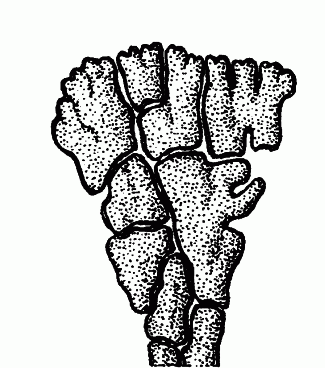Placynthium subradiatum (Nyl.) Arn.
Faded ink
Placynthiaceae
Introduction to the Lichens
Faded ink
Placynthiaceae
Introduction to the Lichens
Map
Distribution of Placynthium subradiatum unavailable
Species Information
General:
Common Name: The Brownette Lichens. Stresses the miniature size and superficial resemblance to certain species of “brown” lichens (e.g., Melanelia and Neofuscelia).
Minute to small stratified to nonstratified foliose or occasionally squamulose lichens, corticate above and below, isidiate or not, lobes closely appressed or partly semi-erect, elongate-linear, linear or occasionally short, averaging to (0.1–) 0.2–0.8 (–l.5) mm wide, thin. Upper surface dark olive-brown or blackish, smooth or longitudinally striate. Lower surface dark or occasionally pale, bearing blue-green or occasionally pale rhizines, these often extending outward from thallus as prothallus. Medulla white. Photobiont blue-green.
Apothecia located over upper surface, disc dark brown to black; spores 2- to 4-celled, ellipsoid to somewhat spindle-shaped/fusiform, colourless, (4-) 8 per ascus.
Over rock, rarely over bark.
Notes: Placynthium is primarily a temperate genus, consisting of approximately 25 species worldwide. Of the six species occurring in North America, five are reported from B.C. In this taxonomically rather difficult genus, conclusive identification of some species requires detailed anatomical studies (see Henssen 1963d). No lichen substances have been reported.
Species description:
Thallus broadly or narrowly attached to substrate, but not umbilicateAND
Thallus brownish; lobes not at all swollen; substrate variousAND
Lobes either mostly appressed to substate or, if erect, then over rock AND
Lower surface and rhizines blue-green or blackish AND
Peripheral lobes essentially continuous with thallus, elongate or short, but never scalelike; hypothallus inconspicuous or absent AND
Over base-rich rock; lobes averaging to 0.2 mm wide or less; thallus sometimes forming concentric rings AND
Upper surface of peripheral lobes distinctly flattened and usually crowded/contiguous at tips; thallus often ring-forming
Comments:
Some specimens can be separated from P. flabellosum only on the basis of anatomical studies. See the notes under that species.
Source: Lichens of British Columbia
Illustration

If more than one illustration is available for a species (e.g., separate illustrations were provided for two subspecies) then links to the separate images will be provided below. Note that individual subspecies or varietal illustrations are not always available.
Illustration By: Trevor Goward
Habitat and Range
Habitat: Rare over (seasonally wetted) base-rich rock in open, inland localitiesWorld Distribution: tentatively western N Am – western Eurasia, S to AZ
Source: Lichens of British Columbia